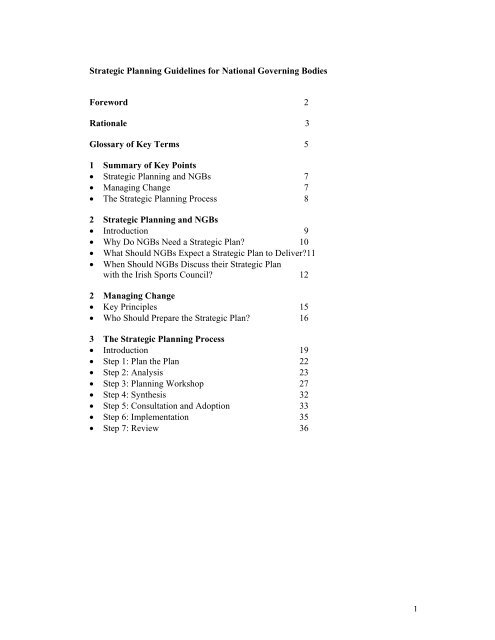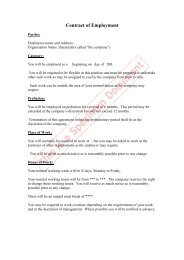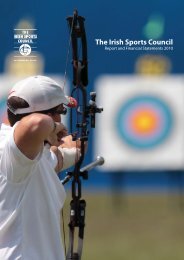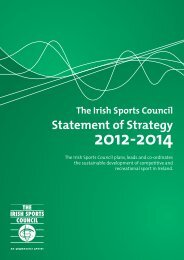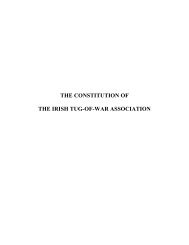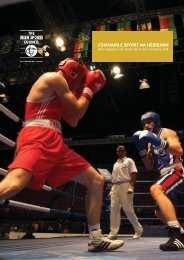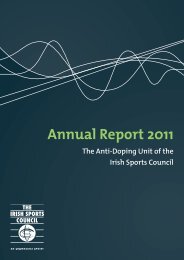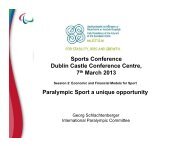Strategic Planning Guidelines - The Irish Sports Council
Strategic Planning Guidelines - The Irish Sports Council
Strategic Planning Guidelines - The Irish Sports Council
Create successful ePaper yourself
Turn your PDF publications into a flip-book with our unique Google optimized e-Paper software.
<strong>Strategic</strong> <strong>Planning</strong> <strong>Guidelines</strong> for National Governing Bodies<br />
Foreword 2<br />
Rationale 3<br />
Glossary of Key Terms 5<br />
1 Summary of Key Points<br />
• <strong>Strategic</strong> <strong>Planning</strong> and NGBs 7<br />
• Managing Change 7<br />
• <strong>The</strong> <strong>Strategic</strong> <strong>Planning</strong> Process 8<br />
2 <strong>Strategic</strong> <strong>Planning</strong> and NGBs<br />
• Introduction 9<br />
• Why Do NGBs Need a <strong>Strategic</strong> Plan? 10<br />
• What Should NGBs Expect a <strong>Strategic</strong> Plan to Deliver?11<br />
• When Should NGBs Discuss their <strong>Strategic</strong> Plan<br />
with the <strong>Irish</strong> <strong>Sports</strong> <strong>Council</strong>? 12<br />
2 Managing Change<br />
• Key Principles 15<br />
• Who Should Prepare the <strong>Strategic</strong> Plan? 16<br />
3 <strong>The</strong> <strong>Strategic</strong> <strong>Planning</strong> Process<br />
• Introduction 19<br />
• Step 1: Plan the Plan 22<br />
• Step 2: Analysis 23<br />
• Step 3: <strong>Planning</strong> Workshop 27<br />
• Step 4: Synthesis 32<br />
• Step 5: Consultation and Adoption 33<br />
• Step 6: Implementation 35<br />
• Step 7: Review 36<br />
1
Rationale<br />
In the <strong>Irish</strong> <strong>Sports</strong> <strong>Council</strong>’s Statement of Strategy, Building Sport for Life, we have<br />
defined our mission as planning, leading and co-ordinating the sustainable development<br />
of sport in Ireland. One of the our priorities is the facilitating the development of sporting<br />
bodies through capacity and capability building within those bodies It is in this context<br />
that the <strong>Irish</strong> <strong>Sports</strong> <strong>Council</strong> has fostered the development of strategic planning in<br />
National Governing Bodies to assists them in delivering on their key goals in an effective<br />
and structured manner.<br />
National Governing Bodies do not deliver their sports in a vacuum. <strong>The</strong>re are many<br />
thousands of dedicated volunteers in local clubs and communities supporting and<br />
administering sport. Without them, sport could not exist.<br />
In conjunction with their volunteer base, many National Governing Bodies are now<br />
moving from the volunteer base to one with full time professional staff. This provides<br />
many challenges to organisations but also allows them to become more strategic and<br />
professional in the delivery of their sports to their members.<br />
<strong>The</strong> priority of National Governing Bodies is to increase access to opportunities for<br />
participation in sport for all as well as developing pathways for athletes towards<br />
excellence. National Governing Bodies are also responsible for the governance of their<br />
sport and ensuring that their organisation is run in a democratic and strategic manner that<br />
is in the best interest of their members..<br />
This resource has been produced by the <strong>Irish</strong> <strong>Sports</strong> <strong>Council</strong> to assist National Governing<br />
Bodies to undertake the strategic planning process. It is based on practical advice for<br />
facilitating the process as well as providing a template of how the strategy should be<br />
drawn together.<br />
2
Glossary of Key Terms<br />
National Governing Bodies (NGBs): <strong>The</strong>se are the National Bodies, affiliated to the<br />
European and World Governing Bodies for that sport, set up to govern and deliver the<br />
sport to their members.<br />
A Board of Directors, made up from representatives of the membership, elected at an<br />
AGM in line with the Rules and Regulations of the organisation.<br />
<strong>Strategic</strong> <strong>Planning</strong>: <strong>The</strong> process whereby the interested parties in the NGB discuss,<br />
agree and describe what is best for their sport and what steps they will take to progress its<br />
development.<br />
Vision: It represents the ultimate aim. <strong>The</strong> members need a vision of what their NGB<br />
should be like at some point in the future. However, visions must also be realistic. A<br />
vision should therefore be challenging but ultimately achievable and reflect the particular<br />
nature of the organisation. A National Governing Body should seek to “sell” its vision to<br />
its internal and external stakeholders so that they can help to achieve it.<br />
Mission: <strong>The</strong> mission of a Governing Body sets out simply what it will do to achieve its<br />
vision. Everything the NGB does, or wants to do, should be tested against its agreed<br />
mission and anything that does not fit the mission should not be progressed.<br />
Core values: <strong>The</strong> “things we believe in” are our core values. Many people believe in<br />
honesty, for example, while others are happy to do dishonest things in order to make<br />
money. Typical examples of NGB core values include equality of opportunity; social<br />
inclusion; fair play; quality training; excellence in standards and that sport should be<br />
valued for its own sake rather for some other reason.<br />
Goals are a key foundation for the NGB’s strategic plan. <strong>The</strong>y are long term aspirations,<br />
which will lead to the achievement of the vision and are compatible with the mission.<br />
Goals are difficult to quantify so it can be difficult to say if they have been fully achieved;<br />
alternatively, it is always possible to do better against them. Typical goals might be “to<br />
promote more participation” or “to develop a more efficient training structure at local<br />
level”.<br />
Objectives are things the NGB will set out to achieve which, if successful, will contribute<br />
3
to the achievement of goals. <strong>The</strong>re may be several objectives related to one goal. For<br />
example, a goal of promoting more participation might lead to a series of objectives such<br />
as:<br />
• To run a club development programme<br />
• To promote the “sport for all” ethos<br />
• To develop links between local schools and clubs<br />
Performance indicators are used to measure whether the NGB is being successful in<br />
relation to its objectives. A performance indicator relating to an objective of encouraging<br />
existing clubs to participate in a club development programme will be the number of<br />
clubs participating this year, next year and so on.<br />
Targets relate directly to performance indicators. <strong>The</strong>y are measurable, realisable,<br />
specific and cover a set time period. A target might be to have ten clubs participate in the<br />
development programme in the next year and another ten to do so the year after.<br />
Stakeholders are people or organisations who will be affected by the NGB and what it<br />
does and may be interested in working with it. Stakeholders can be internal or external.<br />
Internal stakeholders are people, groups and agencies who are part of the NGB with an<br />
interest in how it goes about its work and what it does. For NGBs, the main internal<br />
stakeholders are usually members, officials and coaches, athletes, local sporting<br />
clubs/organisations, local community and voluntary groups and the local people. <strong>The</strong>se<br />
groups and individuals can also be described as the members of the NGB.<br />
External stakeholders are people who are not members of the NGB but interested in<br />
what it does or affected by it. <strong>The</strong>y may include International Federations, facility<br />
owners and providers, the media, sponsors, the <strong>Irish</strong> <strong>Sports</strong> <strong>Council</strong> and Government<br />
Departments/agencies.<br />
SWOT Analysis is used to identify the strengths, weaknesses, opportunities and threats<br />
facing the organisation. Looking at the NGB in this way helps to create a picture of the<br />
current state of play and is often useful in deciding a plan of action.<br />
Summary of Key Points<br />
<strong>Strategic</strong> <strong>Planning</strong> and NGBs<br />
Everyone who has ever taken part in sport is already familiar with the basic concepts:<br />
Decide what you want to achieve – your<br />
mission and related goals<br />
4
�<br />
Agree the rules of the game – your<br />
principles or core values<br />
�<br />
Set measurable objectives which will<br />
contribute to the achievement of your<br />
mission and goals<br />
�<br />
Decide how to go about delivering the<br />
objectives - your tactics or action plan<br />
�<br />
Communicate the proposed mission, goals,<br />
objectives and action plan to everyone who<br />
needs to know them<br />
�<br />
Review and change the action plan as<br />
necessary to ensure it delivers the aims and<br />
objectives as effectively as possible<br />
<strong>The</strong> main reasons NGBs need a strategic plan include:<br />
• To concentrate on the long term interests of their sport<br />
• To identify those things which will deliver desirable long term results most<br />
effectively<br />
• To build effective partnerships/relationships<br />
• To take maximum advantage of the various support services available to them<br />
<strong>The</strong> NGB’s strategic plan should deliver:<br />
• Clarity of purpose<br />
• An action plan with clear targets<br />
• An effective structure<br />
• Long term sustainability<br />
Managing Change<br />
<strong>The</strong> process must be an inclusive one. A comprehensive consultation process should be<br />
utilised fully to ascertain the needs and opinions of members and stakeholders. At<br />
regular intervals the Forum should receive updates on the planning process.<br />
<strong>The</strong> Board of Directors of the NGB has to be committed to the planning process.<br />
<strong>The</strong> process of producing the plan is more important than the plan itself but what really<br />
matters are the results achieved as a result of implementing the plan.<br />
<strong>The</strong> process takes considerable time and effort and there is no single correct way to<br />
produce a strategic plan.<br />
5
A dedicated planning team should undertake the task of preparing the plan with the<br />
assistance of the board. An external facilitator may be called in to assist this team.<br />
<strong>Strategic</strong> planning is not infallible but having a plan reduces the risk of future problems.<br />
NGBs must “own” their problems if they are to determine effective solutions to them.<br />
<strong>The</strong> <strong>Strategic</strong> <strong>Planning</strong> Process<br />
We suggest you follow a seven step process:<br />
• Step 1: Plan the plan<br />
• Step 2: Analysis<br />
• Step 3: <strong>Planning</strong> workshop<br />
• Step 4: Synthesis<br />
• Step 5: Consultation and adoption<br />
• Step 6: Implementation<br />
• Step 7: Review<br />
<strong>Strategic</strong> <strong>Planning</strong> and National Governing Bodies<br />
Introduction<br />
<strong>The</strong> basic concepts of strategic planning are:<br />
Decide what you want to achieve - your<br />
mission and related goals<br />
�<br />
Agree the rules of the game – your<br />
principles or core values<br />
�<br />
Set measurable objectives which will<br />
contribute to the achievement of your<br />
mission and goals<br />
�<br />
Decide how to go about delivering the<br />
objectives – your tactics or action plan<br />
�<br />
Communicate the proposed mission, goals,<br />
objectives and action plan to everyone who<br />
needs to know them<br />
�<br />
Review and change the action plan as<br />
necessary to ensure it delivers the aims and<br />
objectives as effectively as possible<br />
6
<strong>Strategic</strong> planning for all NGBs will follow the same broad approach. It’s a process based<br />
on relevant information and common sense, and does not require specialist expertise.<br />
<strong>The</strong>re are three types of sports organisation:<br />
• Those that wonder what is happening<br />
• Those that watch what is happening<br />
• Those that make things happen<br />
Australian <strong>Sports</strong> Commission, <strong>Planning</strong> in Sport<br />
At the outset, approaching the preparation of a strategic plan can seem a pretty daunting<br />
task. It’s easy to gather a mass of information – but difficult to use that information in a<br />
constructive way to produce a clear and simple plan. It’s easy to think that many of the<br />
problems faced by NGBs are outside their control – but difficult to find ways of taking<br />
greater charge of their own destiny.<br />
<strong>The</strong>se guidelines are designed to help NGBs through the process to produce a viable<br />
programme of work that is supported by all involved in the organisation. Put simply, the<br />
purpose of this guide is to help. However, as each NGB will operate in a different arena<br />
and with a different set of priorities there is a need to adapt them to each NGB’s own<br />
circumstances.<br />
Each NGB should seek to find a method, format and outcomes, which suit its own<br />
particular needs and stage of development. <strong>The</strong> NGBs should also take the opportunity to<br />
discuss the development of their planning process with the <strong>Irish</strong> <strong>Sports</strong> <strong>Council</strong> at regular<br />
intervals.<br />
Why Do NGBs Need a <strong>Strategic</strong> Plan?<br />
<strong>The</strong> main reason NGBs need a strategic plan, is to help them become effective so they can<br />
provide real leadership and co-ordination for sport in their area.<br />
Sport in Ireland is changing rapidly and set to change a lot more over the next decade.<br />
Future changes cannot always be foreseen and because of this some agencies, groups or<br />
individuals might question the sanity of spending time looking for a vision for the NGB in<br />
the long term. NGBs can look at examples from other sectors and see that organisations<br />
that have not planned who have ended up “fire-fighting” and never getting on with their<br />
core business. That is why NGBs should have a strategic plan to help them concentrate on<br />
the long term interest of their sport rather than have to react continually to things over<br />
which they have no control. If the NGB does not provide the leadership, which is needed,<br />
their sport will suffer. Moreover, implementing the plan will direct the work of the NGB<br />
and its executive.<br />
<strong>The</strong>re will always be a limit on the amount of cash and resources available to the NGB to<br />
do all the things they would like to be able to do. <strong>The</strong> NGB should use its strategic plan as<br />
a “window display” for the work that it will carry out and so the plan should assist in<br />
7
attracting resources from partners or sponsors at local level. <strong>Strategic</strong> planning identifies<br />
those things, which will deliver desirable long-term results most effectively. <strong>The</strong>re’s an<br />
old maxim – usually referred to as either the Law of Diminishing Returns or Pareto’s Law<br />
– that 20% of the effort generates 80% of the results in any organisation. Conversely, 80%<br />
of the effort generates 20% of the results. Effective strategic planning aims to identify and<br />
concentrate on the 20% effort and 80% results, not the other way round. This is the very<br />
reason that the <strong>Irish</strong> <strong>Sports</strong> <strong>Council</strong> has chosen to spend its funding on creating NGBs to<br />
facilitate and co-ordinate the efforts of those involved in sport at local level.<br />
NGBs are not alone in having to make do with inadequate resources. Almost every<br />
organisation has a limit on resources available to them, including the <strong>Irish</strong> <strong>Sports</strong> <strong>Council</strong>!<br />
To counteract any shortfall, strong partnerships are needed. So the fourth reason for having<br />
a strategic plan is to build effective partnerships. An effective partnership is one in which<br />
each partner achieves more than would have been possible alone. However, partnerships<br />
are easiest to form when each partner has clear objectives and short and medium term<br />
priorities. It follows that NGBs wishing to work in partnership will have to know exactly<br />
what they want to achieve for their own areas of operation and the resources they will have<br />
available. <strong>The</strong>re may even be instances where different NGBs can work in partnership to<br />
achieve goals common to both.<br />
<strong>The</strong> <strong>Irish</strong> <strong>Sports</strong> <strong>Council</strong> does not so much want as need NGBs to have effective strategic<br />
plans for the following reasons:<br />
• To maximise the impact of all the work done by local clubs/organisations over the<br />
years in order to build an effective support infrastructure for <strong>Irish</strong> sport at national<br />
level.<br />
• NGBs are key partners in the job of breaking down barriers and increasing<br />
participation in sport, not only the number of people but also their continued<br />
participation throughout their lives. This can only be achieved by the <strong>Irish</strong> <strong>Sports</strong><br />
<strong>Council</strong> working in partnership with NGBs. <strong>The</strong> <strong>Irish</strong> <strong>Sports</strong> <strong>Council</strong> needs NGBs to<br />
be strong, dynamic, strategic organisations providing leadership to and enjoying<br />
widespread support from their target groups and members.<br />
• <strong>Irish</strong> <strong>Sports</strong> <strong>Council</strong> is accountable to government for the use of state funding<br />
allocated to sport. In order to be able to make the case for more funding for sport it will<br />
have to be able to demonstrate that both it and its partners are effective. That can only<br />
be done when there is clarity in what the <strong>Irish</strong> <strong>Sports</strong> <strong>Council</strong> and NGBs are trying to<br />
achieve and how the impact of their work can be measured.<br />
• It needs to concentrate its limited resources on delivering the objectives set for it by<br />
government and its own policy priorities. <strong>The</strong>refore it needs to know how and what<br />
NGBs plan to deliver and the support they will need.<br />
“<strong>The</strong>re ain’t no such things as a free lunch” (Crane’s Law)<br />
8
Arthur Bloch, <strong>The</strong> Complete Murphy’s Laws: A Definitive Collection<br />
It follows from this that NGBs preparing a strategic plan do not start with a completely<br />
blank sheet of paper. Instead, from the start they should seek to develop their partnership<br />
with the <strong>Irish</strong> <strong>Sports</strong> <strong>Council</strong> and promote mutual understanding of missions, goals,<br />
responsibilities, resources and strengths. Each NGB’s strategic plan should respond to the<br />
needs of its own area but also take into account <strong>Irish</strong> <strong>Sports</strong> <strong>Council</strong> policies particularly<br />
those relating to participation, inclusion and specific target groups. <strong>The</strong> <strong>Irish</strong> <strong>Sports</strong><br />
<strong>Council</strong>’s role is to work with NGBs in order to make sustainable differences to <strong>Irish</strong> sport.<br />
It is the role of the NGBs to demonstrate that they are delivering results in an effective<br />
manner. This means that their strategic plans must set out clearly what they plan to<br />
achieve, how, when and at what cost.<br />
“<strong>The</strong> best way to anticipate the future is to invent it”<br />
Rosabeth May Kanter, When Giants Learn to Dance<br />
What Should NGBs Expect <strong>The</strong>ir <strong>Strategic</strong> Plan to Deliver?<br />
Ultimately, NGBs’ strategic plans should deliver results. Those results must reflect and<br />
relate to Government and <strong>Irish</strong> <strong>Sports</strong> <strong>Council</strong> policies and priorities but should not be<br />
based only on them. <strong>The</strong>y should also take into account the policies and strategies of other<br />
agencies both national and local. A key strategy to be borne in mind will be the 3-year<br />
strategy of the <strong>Irish</strong> <strong>Sports</strong> <strong>Council</strong>. NGBs should also be aware of central government<br />
policies in relation to target groups in their areas. It follows that the NGB’s strategic plan<br />
must deliver:<br />
• A vision and mission based on consensus, shared values and agreed priorities – a<br />
clearly defined purpose, expressed in a way that all those involved in the NGB<br />
understand and wholeheartedly support<br />
• A clear statement of realistic objectives with achievable outcomes and how they will<br />
be delivered and measured – in other words, an action plan with clear targets<br />
• Long term sustainability: all programmes developed and provided through the NGB<br />
should be sustainable and in line with the long-term plans for the sport.<br />
If the implementation of a strategic plan delivers results there will be a need to review and<br />
amend it from time to time to reflect changing circumstances and build on success. If it<br />
doesn’t, there will be an even more obvious need to review it. This means that strategic<br />
planning is:<br />
• A dynamic, ongoing and systematic process which is never “finished”<br />
9
• A way of building consensus and shared ownership on what constitutes a “desirable<br />
future” and how to achieve it, giving real purpose to the partnership<br />
• A working tool to focus on outcomes over a defined period, using hard facts wherever<br />
possible<br />
• A way of building effective interaction with other bodies<br />
And is not:<br />
• Needed purely to get funding and therefore determined almost completely by the<br />
policies, requirements or assumed expectations of funding bodies<br />
• An occasional burst of activity<br />
• An unrealistic wish list for some time in the future<br />
• Restrictive – it can be changed to suit changing circumstances<br />
• A panacea for all problems<br />
• Good in theory but useless in practice<br />
• Something which takes forever<br />
• A large book, which sits on a shelf or in a drawer<br />
<strong>The</strong> best plans are short and simple – most people cannot be bothered to read long,<br />
involved documents - and implemented.<br />
When Should NGBs Discuss their <strong>Strategic</strong> Plan with the <strong>Irish</strong> <strong>Sports</strong> <strong>Council</strong>?<br />
NGBs should keep the <strong>Irish</strong> <strong>Sports</strong> <strong>Council</strong> apprised of progress at each stage of the<br />
strategic planning process. <strong>The</strong> NGBs are a key delivery mechanism identified in the <strong>Irish</strong><br />
<strong>Sports</strong> <strong>Council</strong> Strategy. As a result, it is important that their strategies are informed of<br />
new developments at national level. <strong>The</strong>refore, the <strong>Irish</strong> <strong>Sports</strong> <strong>Council</strong> and NGBs should<br />
be in regular contact at all stages in the planning process.<br />
Each NGB will decide on how it wants to proceed with its strategic planning. However, in<br />
terms of progressing in line with Government and <strong>Irish</strong> <strong>Sports</strong> <strong>Council</strong> policy priorities and<br />
in the context of the need to create real working partnerships, NGBs should contact the<br />
<strong>Irish</strong> <strong>Sports</strong> <strong>Council</strong>:<br />
1 Before the start of the process: at this point the <strong>Irish</strong> <strong>Sports</strong> <strong>Council</strong> will ensure that the<br />
NGB is fully aware of Government and <strong>Irish</strong> <strong>Sports</strong> <strong>Council</strong> policy. This is the context<br />
in which the plan will be set and should be kept in mind throughout the strategic<br />
planning process.<br />
10
2 Each NGB should be aware of the priorities for its member organisations and should<br />
familiarise itself with their plans and objectives.<br />
3 In the course of development: perhaps after the first draft to discuss “without prejudice”<br />
progress made, so that the NGB gets as much advice as possible from an <strong>Irish</strong> <strong>Sports</strong><br />
<strong>Council</strong> perspective. <strong>The</strong>se discussions should provide NGBs with the opportunity to<br />
present how it sees itself developing. In turn, this will help to create an effective<br />
working relationship between the <strong>Irish</strong> <strong>Sports</strong> <strong>Council</strong> and the NGB as the NGB adopts<br />
and works to deliver on targets set out in its plan. It is important for the NGB to<br />
engage in on-going consultation and discussion with its partners and the local<br />
community. <strong>The</strong>re should also be special dedicated efforts to facilitate the input of<br />
marginalized and disadvantaged groups.<br />
4 At the time of submitting its application for core and challenge funding the strategic<br />
planning process will have helped NGBs to focus on goals, targets and evaluation<br />
systems. Coupled with the work carried out in the planning process, NGBs should have<br />
clear expectations of the level of <strong>Irish</strong> <strong>Sports</strong> <strong>Council</strong> support for their plans. <strong>The</strong>y<br />
should also include the levels of input required from partners to ensure the plan can be<br />
implemented.<br />
11
Managing Change<br />
Key Principles<br />
“Where there’s a will, there’s a won’t” (Gaultieri’s Law of Inertia)<br />
Arthur Block, Murphy’s Law Book Three: Wrong Reasons Why Things Go More<br />
Whatever approach a particular NGB takes to the preparation of its strategic plan, there<br />
are a number of key principles it should bear in mind from the start.<br />
“<strong>The</strong> business that is not being purposefully led in a clear direction which is understood<br />
by its people is not going to survive”<br />
Sir John Harvey-Jones, Making it Happen: Reflections on Leadership<br />
First, the leadership of the NGB has to be committed to the planning process and the<br />
eventual plan right from the outset. If they sit on the fence until it is finished, and then<br />
pick and choose the bits they like, the plan is probably doomed. It’s also the case that if<br />
there is no commitment to the plan from the start, those in positions of authority may feel<br />
they don’t have to argue their case fully during the planning process because they can<br />
tinker with the final plan later.<br />
Second, the process must be an inclusive one, which involves all key stakeholders<br />
including the membership. Canvassing the views of partners and members and involving<br />
them in key decisions can be difficult and people may have difficulty in making<br />
constructive suggestions for the future. This is particularly the case when clubs and other<br />
stakeholders doubt that real change is about to happen. If all the elements of the NGB<br />
can be persuaded that a strategic plan really will deliver the proposed outcomes this<br />
suspicion can be overcome.<br />
NGBs have responsibilities relating to the general development of sport amongst current<br />
non-participants. <strong>The</strong>se guidelines have already emphasised the importance of working<br />
in partnership whenever possible. Potential partner agencies (sponsors, private facility<br />
operators, etc) can be regarded as NGB “stakeholders”: what they do will affect, or be<br />
affected by, the work of the NGB. <strong>The</strong>refore it makes sense to bring them into the<br />
process, particularly as they can also offer a useful external perspective and different<br />
experience. <strong>The</strong> more that an NGB can base its planning on wide consultation the better.<br />
“Any organisation, which has been through an effective planning process can throw away<br />
its plan because everyone should know what is in it, why and be keen to implement it.”<br />
American management guru Tom Peters<br />
2<br />
12
Third, the process is more important than the agreed plan document – which, for<br />
some people, can almost be the purpose of the process. It is the process of preparing the<br />
plan that generates consensus and shared ownership, not the final printed document,<br />
however good it may be. This reinforces the need for an inclusive planning process. A<br />
key role for the <strong>Strategic</strong> <strong>Planning</strong> Committee will be to facilitate this process and ensure<br />
that all views are taken on board.<br />
Fourth, what really matters are the results achieved as a result of the planning process<br />
and implementing the plan. A strategic plan is not prepared for its own sake, but to<br />
determine and deliver desired outcomes. Desired outcomes for the NGBs would include<br />
improved opportunities for participation and better educational opportunities for<br />
volunteers and staff. It is also important to bear in mind that the new developments are<br />
sustainable and that the outcomes will benefit the sport in the wider sense.<br />
Fifth, the process takes considerable time and effort but should be based on common<br />
sense and not over-complicated or reliant on management jargon. <strong>The</strong> time spent on the<br />
planning process is time well spent if it ensures that the plan produced is truly<br />
representative of the interests of the local area.<br />
Sixth, there is no single, “correct” way to produce a strategic plan; different NGBs<br />
have different needs, face different problems and have different resources and skills.<br />
<strong>The</strong> experience of the <strong>Irish</strong> <strong>Sports</strong> <strong>Council</strong> will prove very beneficial to NGBs in figuring<br />
out what method works best for a sport of their demographics and profile.<br />
Lastly, the NGB should be aware of the need for it to proof its strategic plan in relation to<br />
inclusion, equality, social, economic and cultural policies.<br />
<strong>The</strong> proofing process involves ensuring that key topics and themes are explicitly taken<br />
into account in a Strategy. <strong>The</strong>re should be an element of formality in terms of both<br />
process and a record of its having occurred. Proofing should occur over the period of<br />
preparation and should be built into implementation, monitoring and evaluation. <strong>The</strong><br />
<strong>Irish</strong> <strong>Sports</strong> <strong>Council</strong> has been involved in the proofing process when developing their<br />
own plans and therefore, their experience will inform the work of the planning team of<br />
the NGB.<br />
“<strong>The</strong> strategy was prepared over the course of a three month period by a strategy team,<br />
representative of various grades and work areas in the Department, set up to oversee and<br />
drive the process. Senior management at head of division level met on a number of<br />
occasions and discussed mandate, mission, stakeholders, customer/client expectations and<br />
environmental issues. Subsequently there was an extensive consultation process with all<br />
members of staff. Workshops, with independent facilitators, allowed staff in each<br />
division to challenge and build upon the work already initiated by the strategy team and<br />
senior management.”<br />
Department of Tourism, Sport and Recreation, Statement of Strategy 1998-2001<br />
13
Who Should Prepare the <strong>Strategic</strong> Plan?<br />
Each NGB has to adapt the methods described in these guidelines to suit its own needs. It<br />
is accepted that strategic planning must involve wide-scale consultation to reinforce the<br />
partnership’s sense of ownership. <strong>The</strong> plan should not be prepared by one or two officebearers<br />
or specialist “experts” working in isolation; if it is, the plan will almost certainly<br />
lack the support required for its successful implementation.<br />
<strong>The</strong> best approach may be to create a small planning team, with a specific individual<br />
given the job of drafting the plan. <strong>The</strong> role of the planning team is very much an<br />
overseeing one, as it should not undertake the work itself. Its job is to be a sounding<br />
board; identify individuals or organisations that should be consulted; prevent the plan<br />
heading off on irrelevant tangents; monitoring progress; and keeping their membership<br />
informed.<br />
<strong>The</strong> planning team should be a sub-committee of the Board of Directors. <strong>The</strong> planning<br />
team should carry out their work under the general superintendence and control of the<br />
Board.<br />
<strong>The</strong> Use of External Facilitators<br />
External facilitators can be used in two main ways. <strong>The</strong> first is to appoint consultants to<br />
work for the NGB and prepare a draft plan for it to consider. This will almost never be<br />
successful. <strong>The</strong> consultant will be objective, certainly, but this approach does not lend<br />
itself to building the shared ownership of the plan, which is essential to success.<br />
Moreover, however good or bad the plan may be, it will be too easy for those who do not<br />
like “the consultant’s plan” for some reason – for example, it may threaten their position<br />
– to argue that it will not deliver the required results or does not reflect the NGB’s views<br />
adequately and therefore should be ignored. In these circumstances the money spent on<br />
the consultant will be wasted.<br />
<strong>The</strong> second approach is to use an independent facilitator to help the NGB shape its<br />
thinking (but not do that thinking) and prepare its plan. This approach is likely to be<br />
more successful as an independent outsider will assist the plan preparation but remain<br />
under the control of the NGB. This approach was used by the <strong>Irish</strong> <strong>Sports</strong> <strong>Council</strong> to<br />
assist in the preparation of its strategy, Building Sport for Life. If the NGB decides to<br />
appoint an external facilitator they should consult with the <strong>Irish</strong> <strong>Sports</strong> <strong>Council</strong> before<br />
and at the time of the appointment.<br />
<strong>The</strong> advantages of using an independent facilitator in this way are usually:<br />
• Outsiders are objective and do not bring with them “past baggage”<br />
• Outsiders may not know (and may well be uninterested) in fine detail but should be<br />
able to identify key issues<br />
• Outsiders’ involvement is time-limited and so they can open up cans of worms, which<br />
14
will not be popular with some individuals – although others may heave a sigh of relief<br />
• Outsiders provide a focus for fostering change and may well have relevant experience<br />
of how other organisations operate<br />
• Outsiders are a temporary extra resource for the NGB, not involved in day-to-day<br />
administration and therefore able to spend time thinking, talking and facilitating the<br />
planning process.<br />
<strong>The</strong> <strong>Strategic</strong> <strong>Planning</strong> Process<br />
Introduction<br />
All strategic plans have three basic elements:<br />
• Where are we today? – the starting point for the plan<br />
• Where do we want to be at some time in the future? – the vision, mission, goals and<br />
objectives<br />
• How do we get there? – the action plan<br />
<strong>The</strong> process of actually producing a plan isn’t so easily structured under these three<br />
headings; for example, they do not obviously include a means of getting a plan adopted or<br />
a regular review of it. One answer is to follow a seven-step process:<br />
• Step 1 Plan the plan<br />
• Step 2 Analysis<br />
• Step 3 <strong>Planning</strong> Workshop<br />
• Step 4 Synthesis<br />
• Step 5 Consultation and adoption<br />
• Step 6 Implementation<br />
• Step 7 Review<br />
<strong>The</strong> process, and the role of the various “key players” involved in it, is summarised<br />
below.<br />
3<br />
15
Step 1: Plan the Plan<br />
Before the work of actually producing the plan can really start, a number of key decisions<br />
have to be taken. <strong>The</strong>se decisions will affect the eventual outcome, so they require<br />
careful consideration:<br />
• <strong>The</strong> composition of the “planning team”: the last section suggested the creation of a<br />
team to oversee the planning process. This should be a group of no more than about<br />
half a dozen people – more than this and it can be very difficult to arrange meetings –<br />
who are committed to the long term good of the NGB. Ideally, they should have no<br />
personal axes to grind: they are on the planning team to represent the area as a whole,<br />
not a particular interest group/sport.<br />
• How the plan is going to be prepared: at the outset it is important to determine<br />
whether the plan preparation is to be done completely “in-house” or will involve an<br />
external facilitator and the broad approach to be adopted. This guide is intended as a<br />
template, which NGBs can adapt to their own particular needs.<br />
• Identify key internal stakeholders: NGBs have a number of internal stakeholders<br />
who will be affected directly by the planning process and outcomes of the plan.<br />
<strong>The</strong>se will include:<br />
� <strong>The</strong> NGB’s partners<br />
� Its members<br />
� Professional staff: NGB staff is likely to be affected by the preparation of a<br />
strategic plan. Staff must be included in the process, otherwise might gain the<br />
impression the plan is being prepared behind her/ his back.<br />
� Others (this is dependent on specific NGB circumstances)<br />
• Decide on the key external stakeholders: NGBs also have external stakeholders –<br />
the organisations with which they interact such as clubs, sponsors, the <strong>Irish</strong> <strong>Sports</strong><br />
<strong>Council</strong> and Government Departments. In addition, if there are outside organisations<br />
with which the NGB is likely to wish to work in partnership, it will often help to bring<br />
them in to the planning process. In many instances external stakeholders will not<br />
wish to be involved on an ongoing basis but this does not mean they should be<br />
ignored.<br />
• Set a broad timetable for the planning process: preparing a strategic plan nearly<br />
always takes longer than expected at the outset, so build some “float” time into any<br />
programme for the preparation of a plan. When setting the overall programme, the<br />
key dates on which to base the plan timetable are usually:<br />
� <strong>The</strong> end of the financial year: the best time to start implementing a new strategic<br />
plan is at the beginning of an ISC funding year. This allows an existing budget to<br />
continue while the plan and related new budget are prepared<br />
� When the NGB has to submit its plan to the <strong>Irish</strong> <strong>Sports</strong> <strong>Council</strong>. Any deadline set<br />
by the <strong>Council</strong> will obviously be a critical date to take into account when planning<br />
16
the plan. Any NGB will want to ensure that the <strong>Irish</strong> <strong>Sports</strong> <strong>Council</strong> will be<br />
willing to support its plan before submitting it. Accordingly it will be imperative<br />
to discuss the plan as it evolves with the <strong>Irish</strong> <strong>Sports</strong> <strong>Council</strong> and the <strong>Guidelines</strong><br />
indicate appropriate stages in the planning process to do this.<br />
<strong>The</strong> other key elements of Step 1 are:<br />
• Give a commitment to implement the plan before it is started; this will demonstrate<br />
to the community and <strong>Irish</strong> <strong>Sports</strong> <strong>Council</strong> that the NGB is taking the planning<br />
process seriously. In turn, this should help to bring people into the process because<br />
they realise that change is possible.<br />
• Let all elements of the NGB know about the proposal to prepare a strategic plan, the<br />
make-up of the planning team, why the plan is needed, the timetable for its production<br />
and invite contributions. It is almost inevitable that rumours about the content of the<br />
plan will start and the planning team should be open and the process transparent right<br />
from the start.<br />
• Ensure that the existing administrative structure is able to “keep the show on the<br />
road” during the planning process.<br />
Step 2: Analysis<br />
<strong>The</strong> first step in the actual plan preparation is to prepare a statement of “where we are<br />
today”. As much as possible this should be factual, although conclusions and trends<br />
should also be included. <strong>The</strong> analysis should relate to both the external context within<br />
which the NGB operates and its own internal policies and those of its partners. <strong>The</strong> <strong>Irish</strong><br />
<strong>Sports</strong> <strong>Council</strong> will be in a position to contribute to this work from a national policy<br />
perspective. Its overall purpose is to set the scene for the remainder of the planning<br />
process. It does this by identifying the context within which the plan will be set; taking<br />
stock of what the NGB will do, and summarising the key issues the strategic plan must<br />
tackle.<br />
2A: <strong>The</strong> External Context<br />
No plan exists in isolation; instead, it is set in a particular context and should be part of a<br />
“cascade” of plans, which should inter-relate and reinforce each other. This cascade is<br />
both “top down” and “bottom up”. In top down terms, for example, the policies and<br />
priorities in the <strong>Irish</strong> <strong>Sports</strong> <strong>Council</strong>’s Building Sport for Life (2005) set the context for<br />
the <strong>Council</strong>’s policies; these set the context for NGB plans; and they set the context for<br />
members’/clubs’ plans. However, NGBs will have to obtain the support not only of the<br />
<strong>Irish</strong> <strong>Sports</strong> <strong>Council</strong> but also of their partners and forum for their plan and therefore will<br />
have to take full account of their wishes when preparing it - the bottom up part of the<br />
planning cascade. This may seem very bureaucratic at first, but is actually common sense<br />
because ultimately it means everyone should be pulling in the same direction.<br />
17
<strong>Irish</strong> <strong>Sports</strong> <strong>Council</strong> strategy and policies<br />
�<br />
NGB <strong>Strategic</strong> Plans<br />
�<br />
Members’ and Clubs’ expectations<br />
<strong>The</strong>re is no need for the external analysis to be long or complex: a bullet point summary<br />
of no more than about a dozen key points which the NGB should take on board is usually<br />
adequate. One way of structuring them is under four headings in a “PEST” analysis:<br />
• Political factors such as the government’s commitment to increasing participation in<br />
sport by those who are disadvantaged for some reason, particularly young people, and<br />
its desire for greater accountability in voluntary bodies<br />
• Economic factors such as the potential sport offers to create employment or work<br />
with tourism interests<br />
• Social factors such as the changing role of work patterns or emerging health concerns<br />
such as obesity in children<br />
• Technological factors such as competition from computer games for children’s time<br />
and the impact of the internet and e-mail on NGB administration<br />
It can be useful to follow each bullet point in a PEST analysis by its implication for the<br />
NGB: for example, one implication of changing work patterns is that there may be scope<br />
to develop coaching courses for adult participants during normal working hours.<br />
2B: Internal Analysis<br />
<strong>The</strong> internal analysis, perhaps paradoxically, can be a lot more difficult; certainly it<br />
should be wide-ranging and cover all the current work of the partners in the NGB. Again,<br />
the analysis need not be long-winded and can be prepared in bullet point form. But it<br />
must build up to a factually based, wholly objective and, if necessary, brutally frank<br />
picture of the NGB.<br />
Wherever possible, basic facts and figures should relate to the way in which the NGB is<br />
structured. This will also allow the NGB to identify trends over time and benchmark its<br />
performance against other NGBs. <strong>The</strong> main areas to review are described below.<br />
18
Established mission, aims and objectives<br />
Every NGB should have a statement in its Memorandum and Articles of its “objects” –<br />
the reasons why it exists.<br />
Basic facts and figures<br />
Current data for the organisation will have been collated during the planning process of<br />
the NGB. This information will be useful to the NGB in identifying target groups/areas<br />
that should be focussed on in the future through the strategic plan.<br />
• Baseline figures on participation levels in the organisation.<br />
• Club membership figures<br />
• Demographic information relating to gender and age breakdown, socio-economic<br />
groups and the prevalence of people with a disability in the local community<br />
• <strong>The</strong> number of clubs, coaches and leaders<br />
Stakeholder views<br />
NGBs may have many stakeholders, each with a view of what it should be doing and how<br />
it is currently performing.<br />
This can be gauged by:<br />
• Undertaking a questionnaire survey of stakeholders<br />
• NGB database/wealth of experience<br />
• Arranging roadshows or consultation meetings<br />
• Establishing the views of external stakeholders and the potential for developing<br />
partnerships with them<br />
Volunteering<br />
<strong>The</strong> <strong>Irish</strong> <strong>Sports</strong> <strong>Council</strong> is aware that it is becoming more and more difficult to attract<br />
volunteers and that some NGBs may wish to address this in their strategic plan. As a<br />
result, NGBs may need to review trends in volunteering to identify the extent to which<br />
new volunteers are coming forward and, if there is a problem, why this should be so.<br />
Facilities<br />
Most sports require facilities but Ireland is only beginning to build a good range of<br />
facilities. Review the provision of facilities – for example, their quantity, quality,<br />
location, who owns them, and how the NGB can use them. Although the <strong>Irish</strong> <strong>Sports</strong><br />
<strong>Council</strong> does not control the funding of sports facilities, the NGBs should be involved in<br />
providing advice to their members making capital grant applications on behalf of their<br />
clubs to the Department of Arts, Sport and Tourism.<br />
Partnerships/Support Services<br />
<strong>The</strong> NGB itself will not have the resources to allow it to do everything, which might be<br />
desirable to develop their sport and so must actively seek to develop close links with its<br />
19
partners and to make use of available support services. Review:<br />
• Opportunities for the NGB to work effectively with partners<br />
• <strong>The</strong> NGB’s potential in getting and keeping sponsors for its programmes, bearing in<br />
mind that a range of tried and tested programmes will be available from the <strong>Irish</strong><br />
<strong>Sports</strong> <strong>Council</strong><br />
Image and Communications<br />
Sport is competing with many other activities for participants and so effective public<br />
relations are essential. Review:<br />
• <strong>The</strong> image of sport nationwide<br />
• Marketing and promotion of programmes<br />
Administration and Use of Information Technology<br />
Information technology should have had a significant impact on the way NGBs operate in<br />
ways ranging from the use of simple mailing lists to desktop publishing and e-mail. As<br />
many people interested in the work of the NGB will be able to access the internet either at<br />
home or work, it may be possible to be more effective by using e-mail. <strong>The</strong>re may also<br />
be other ways in which administrative procedures could be streamlined such as availing<br />
of shared services provided by the <strong>Irish</strong> <strong>Sports</strong> <strong>Council</strong>.<br />
Finance<br />
<strong>The</strong> easiest, most common and by far the worst way to produce a budget is to take last<br />
year’s income and expenditure figures and add a percentage for inflation. Such an<br />
approach stifles change. As organisations with limited financial resources of their own,<br />
NGBs need to use money as effectively as possible. It will help to split expenditure into<br />
“pay” (including PRSI contributions) and “non-pay” costs such as training courses, travel<br />
and subsistence, postage and telecommunications, printing and office supplies,<br />
merchandise costs, office premises, consultancy/legal/audit services, insurance and<br />
incidental expenses.<br />
20
In broad terms, the less NGBs depend on grant aid the more they are their own masters.<br />
NGBs should bear in mind that support from the <strong>Irish</strong> <strong>Sports</strong> <strong>Council</strong> is split between<br />
Core and High Performance funding (if applicable). Financial planning should also take<br />
into account the inputs that will be made by the partners to the company particularly in<br />
relation to core costs.<br />
Outcomes<br />
<strong>The</strong> ultimate emphasis in any strategic plan must always be on outcomes – what is<br />
actually achieved. In order to provide basic information for the plan, compare inputs (for<br />
example, of cash and time) with outcomes and try to determine value for money, if<br />
necessarily on a subjective basis. It is often the case that large amounts of time and<br />
money are expended to achieve relatively little – an example of the 80:20 rule in action.<br />
“You can’t make an omelette without breaking eggs”<br />
Josef Stalin<br />
2C: Summary Report<br />
<strong>The</strong> outcome of Step 2 should be a “warts and all” summary of the findings of the<br />
analysis stage which also sets out the key issues the NGB must tackle and the resources it<br />
already has available or could seek to get in the future. It does not need to be particularly<br />
long (a bullet point format is usually fine) but must be clear and identify the key issues<br />
the NGB must tackle. It can also be useful to include a SWOT analysis, although there is<br />
often a tendency to view this as an end in itself, including too much and then taking little<br />
notice of it. Useful headings for the analysis report can include:<br />
• Structure<br />
• Resources: essentially money and other inputs<br />
• Performance benchmarking<br />
� Organisation, co-ordination and communication<br />
� Training of volunteers<br />
� Sport for disadvantaged/targeted groups<br />
� Recreational sport<br />
� Performance Pathways<br />
� Coach education, development and deployment<br />
� Facilities<br />
• Club development<br />
• Marketing and promotion<br />
• Key issues for the future<br />
Each section should identify existing objectives and targets if they exist; resources used to<br />
try to deliver them; and outcomes.<br />
At this stage it can be useful to get an independent response to the analysis from someone<br />
who knows the NGB and the people involved in it but not part of it.<br />
21
As likely as not, rumours will start as soon as the analysis report is produced and some<br />
people will convince themselves, often with no evidence that it has been or will be kept<br />
from them. Such rumours and misinformation can seriously harm the strategic planning<br />
process because they usually take a disproportionate amount of effort to overcome and<br />
divert attention from more important matters. If someone asks for a copy, make sure they<br />
get it – another reason for keeping the Analysis Report as short as possible. It will also be<br />
sensible to circulate the analysis report to partners and clubs (as appropriate e.g. post on<br />
website) to make the point that the whole of the planning process is open and transparent.<br />
Step 3: <strong>Planning</strong> Workshop<br />
NGBs may find gathering a mass of analytical information comparatively easy but<br />
deciding what to do with it is much more difficult. One response is to undertake more<br />
analysis, but this can be counter-productive because the problem of deciding what is<br />
really important becomes even more difficult. However, Step 3 is the critical one in<br />
terms of shaping the eventual plan because it is the stage in which the “big” decisions are<br />
taken. <strong>The</strong>se big decisions relate primarily to three things:<br />
• <strong>The</strong> NGB’s vision of the future<br />
• <strong>The</strong> NGB’s mission<br />
• <strong>The</strong> NGB’s key goals<br />
Those involved in this stage of the process must take care not to get bogged down in<br />
detail; instead they must concentrate on setting the overall direction and priorities of the<br />
NGB for the next few years. This means that they must ignore individual interests or<br />
loyalties and seek instead to “invent” the role of the NGB. Furthermore, the process must<br />
neither be rushed nor led by any particular interest group within the NGB.<br />
Possible approaches are:<br />
• <strong>The</strong> planning team can undertake the task.<br />
• One or two day intensive, interactive workshop with key people who will be involved<br />
in implementing the eventual plan, although not all of them should be Directors.<br />
While the other approach may be appropriate in some instances, in most cases a planning<br />
workshop offers the best prospect of success. Key characteristics of successful<br />
workshops are:<br />
• <strong>The</strong>y should last a minimum of a day and ideally a weekend from say lunchtime on<br />
the Saturday to after lunch on the Sunday.<br />
• <strong>The</strong>y should involve 12-20 people, carefully selected to include a blend of those<br />
already involved and people not directly involved at present, but with their own views<br />
on how the NGB should develop in future. Again, it may be worth including some<br />
22
individuals who have been critical of the NGB, provided they can be constructive. If<br />
appropriate, workshops may also include one or two key external stakeholders or<br />
potential partners.<br />
• <strong>The</strong>y should be planned and led by someone who is not aligned with any constituent<br />
part of the NGB so that all present can see them as neutral with no particular axe to<br />
grind. This will often, although not necessarily, require an external facilitator.<br />
• <strong>The</strong>y should be held at a “neutral” venue, not associated with any specific part of the<br />
NGB (such as n hotel or University) so that participants will not be distracted or<br />
called away.<br />
• <strong>The</strong> venue must be equipped with visual aids (at least a flip chart and whiteboard and<br />
possibly an overhead projector and screen) and space for the workshop to split into<br />
small groups from time to time.<br />
A well planned and facilitated workshop is both stimulating and exhausting. It will tend<br />
to be most effective when all those present already know one another as this will save<br />
time on “ice-breaking”. <strong>The</strong>re must also be two ground rules, rigidly enforced by the<br />
facilitator:<br />
• <strong>The</strong> workshop is concerned with the future, not the past: it should not go over old<br />
ground and re-visit old arguments<br />
• <strong>The</strong>re are no sacred cows: anything can be scrapped or changed<br />
<strong>The</strong> key outcomes needed from the workshop are usually:<br />
• A vision of what the NGB wishes itself to be like in the future<br />
• A mission statement for the NGB designed to lead to the delivery of the vision<br />
• <strong>The</strong> NGB’s core values or principles on which the plan will be based<br />
• A small number (no more than 5 or 6, the fewer the better) of broad goals for the<br />
NGB, derived from the mission, each with a limited number of related measurable<br />
and time-related objectives<br />
• Agreement on a limited number of programme or functional areas (again, no more<br />
than 5 or 6) to which the various aims and objectives can be linked. <strong>The</strong>se<br />
programme or functional areas will probably set the future structure of the NGB.<br />
<strong>The</strong> agenda for the workshop will depend upon the NGB, but is normally likely to<br />
include:<br />
• Introductions – make sure everyone knows one another<br />
• Analysis report – review to agree key conclusions and key issues the plan must tackle<br />
23
• SWOT analysis for the NGB<br />
• Determine the vision for the future<br />
• Determine the NGB’s mission<br />
• Identify desirable goals or outcomes, in order of priority<br />
• Determine objectives to deliver the goals<br />
• Identify programme areas<br />
<strong>The</strong> workshop should be planned in such a way that all participants are encouraged by the<br />
facilitator to contribute and as a mixture of plenary and small group sessions.<br />
“Man is limited not so much by his tools as by his vision”<br />
Richard Pascale and Anthony Anthos, <strong>The</strong> Art of Japanese Management<br />
<strong>The</strong> Vision<br />
<strong>The</strong> ultimate purpose of a strategic plan is to deliver a desirable future. Accordingly it is<br />
essential to decide, right at the outset, what that desirable future will be. This is the vision<br />
of a successful NGB. It is most easily determined by imagining the NGB as highly<br />
successful in 4-5 years time and then answering nine key questions:<br />
• Why will the NGB be successful?<br />
• What will “successful” mean?<br />
• What will the NGB be doing?<br />
• Who will be involved in the NGB?<br />
• How will the NGB be operating?<br />
• What would happen if the NGB disbanded?<br />
• What will partners and the local community think or say about the NGB?<br />
• What will the NGB actually be achieving?<br />
• What differences will the NGB be making to its local area?<br />
If possible, the vision should be distilled down to one or at most two reasonably short<br />
sentences with which everyone at the workshop agrees. <strong>The</strong> shorter the vision, the better,<br />
because then workshop participants – and ultimately everyone involved in the NGB- will<br />
remember it. A long-winded vision is easily forgotten and therefore ignored. In addition<br />
it must be must be realistic but also inspire. However, a vision statement that is<br />
hopelessly over-ambitious is likely to be laughed out of court. Equally, a turgid and<br />
conservative one will fail to generate enthusiasm.<br />
24
For examples the <strong>Irish</strong> <strong>Sports</strong> <strong>Council</strong> vision sees Ireland as a country in which:<br />
• Everyone is welcomed and valued in sport, irrespective of their ability and<br />
background<br />
• Individuals can develop their sporting abilities and enjoyment, limited only by<br />
their talent and commitment<br />
• <strong>Irish</strong> sportsmen and women achieve consistent world class performance, fairly<br />
Mission<br />
An organisation’s mission statement sets out its fundamental purpose for existing – what<br />
it will do itself in order to deliver the vision it has set. Here are some examples:<br />
• <strong>The</strong> Walt Disney Company: To make people happy<br />
• Australian <strong>Sports</strong> Commission: To enrich the lives of all Australians through sport<br />
• Hillary Commission: All New Zealanders participating and achieving in sport,<br />
fitness and leisure<br />
• <strong>Irish</strong> <strong>Sports</strong> <strong>Council</strong>: To plan, lead and co-ordinate the sustainable development of<br />
sport in Ireland<br />
<strong>The</strong> purpose of having a mission statement is to set out with absolute clarity what an<br />
organisation seeks to achieve. It can then be used to test proposals for any new<br />
programme or other initiative. If it will help to deliver the mission it can be pursued,<br />
subject to the availability of resources; if not, forget it. A mission statement should<br />
therefore be very powerful: not only should it set out what an organisation wants to<br />
achieve, but by implication it also identifies those things it will not do.<br />
<strong>The</strong> key questions to consider when preparing a mission statement are usually:<br />
• Why do we exist?<br />
• What purpose do we aim to fulfil?<br />
• Who are our primary targets?<br />
• How do we intend to deliver our vision?<br />
Like the vision, and for the same reason, short, simple mission statements are far better<br />
than long ones: Disney’s four-word approach is therefore close to ideal. A good rule of<br />
thumb is never to include more than one “and”, other than in phrases like “sport and<br />
recreation”. If the NGB cannot set out its fundamental reason for existence in a single,<br />
tight sentence, either it doesn’t really have a fundamental purpose or it’s trying to do far<br />
too much. <strong>The</strong> more complex an organisation is, and the more diffuse its purpose, the<br />
more difficult it is to manage. In addition, its members and customers or clients will also<br />
find its purpose unclear. <strong>The</strong> mission of a shoe shop is to make a profit by selling shoes<br />
25
and as this is normally clear to customers they don’t waste their own or assistants’ time<br />
asking for books, flowers or whatever. A department store, comparatively speaking, is a<br />
management and customers’ nightmare. This is one reason why many department stores<br />
have disappeared: they cannot compete effectively with tightly focused and more efficient<br />
speciality shops.<br />
“In everything we do, we will promote best practice.” More specifically:<br />
• As sport has the potential to enrich the lives of everyone, no one should be<br />
excluded from it on the grounds of gender, disability, religion, ethnic origin or<br />
sexual orientation. In all our work, therefore, we will promote inclusiveness.<br />
• We will be an open, honest and accountable organisation, which seeks to base its<br />
decisions on objective evidence in preference to unsubstantiated opinions.<br />
Core Values<br />
We all believe in a number of core values or principles – the things we believe in - which<br />
guide the way we live our lives. Unfortunately not everyone believes in exactly the same<br />
things, which is of course one reason why we have political parties and arguments. <strong>The</strong><br />
research leading to the production of Targeting Sporting Change in Ireland generated<br />
widespread agreement that the development of sport should encompass seven core<br />
principles:<br />
• A people centred focus<br />
• Equality<br />
• Partnership<br />
• Quality<br />
• Accountability<br />
• Volunteerism<br />
• Sustainability<br />
• We will co-operate with and support other agencies and organisations that share<br />
our desire to promote sport and through it a better quality of life.<br />
”Building Sport for Life” <strong>The</strong> <strong>Irish</strong> <strong>Sports</strong> <strong>Council</strong> ‘s Strategy 2005-2008<br />
To these must be added an ethical approach to sport – condemnation of drug abuse or<br />
other forms of cheating and a concern to safeguard the welfare of children. <strong>The</strong>se<br />
principles, or core values, underpin the whole development of sport in Ireland. It is<br />
desirable for NGBs also to summarise their core values clearly as this will help to define<br />
the “organisational culture” within the NGB.<br />
26
Key Goals and Objectives<br />
<strong>The</strong>re are likely to be a number of ways in which the NGB can set out to pursue its<br />
mission in order to achieve its vision. <strong>The</strong> workshop should try to identify a limited<br />
number of key goals, which will do this – five or six are usually ample. With more than<br />
this, the NGB’s efforts and resources will have to be spread thinly and may achieve little.<br />
Goals do not have to be quantified but they must lead directly to the achievement of the<br />
vision and be compatible with the mission. <strong>The</strong> simplest way of identifying suitable<br />
goals is usually:<br />
• Break the vision down into its constituent parts<br />
• Decide what will have to be done to deliver each component of the vision; and<br />
• Test each potential initiative or programme against the mission – is it our job to do<br />
this?<br />
Once goals are agreed, it should be possible to set out the action, which will be needed to<br />
achieve them.<br />
27
Programme Areas<br />
Finally, if there is time, the workshop should seek to allocate the various objectives to a<br />
series of “programme areas”. Most NGBs will be able to identify a small number of<br />
programme areas such as:<br />
• Finance<br />
• Administration<br />
• Club development<br />
• Marketing and promotion<br />
• Volunteers’ and coaches’ development and deployment<br />
• Target groups<br />
Step 4: Synthesis<br />
<strong>The</strong> outcomes from the planning workshop set the overall direction of the NGB for the<br />
future. However, the workshop will almost certainly not have had the time to decide all<br />
the tasks, which will have to be undertaken, the resources which will be needed and who<br />
will be responsible for progressing each of them. This is done in Step 4, the Synthesis,<br />
the outcome of which will be the draft strategic plan.<br />
Preparing the first draft of the plan is not a job for a committee: the result will be a camel<br />
rather than a horse. Instead, it is usually better to entrust the job to an individual. <strong>The</strong><br />
individual will:<br />
• Take the results of the workshop and put them down on paper in a structured and<br />
balanced way<br />
• Flesh out the various objectives agreed at the workshop into a series of “action plans”<br />
based on appropriate tasks<br />
<strong>The</strong> way in which the plan is structured will significantly affect the way it is used and<br />
therefore its effectiveness. It should be based on a hierarchical approach of:<br />
• <strong>The</strong> NGB’s vision and mission<br />
• <strong>The</strong> NGB’s core values<br />
• What the NGB wants to achieve – its goals<br />
• <strong>The</strong> NGB’s specific objectives related to each of its goals<br />
• An action plan for achieving each objective<br />
4A: Mission, Vision, Core Values, Goals and Objectives<br />
Immediately after the workshop, with agreement on the overall future direction of the<br />
NGB and a head of steam behind its emerging plan, there is perhaps a danger of going too<br />
fast for the organisation. <strong>The</strong> workshop participants may not in fact have been<br />
representative of the NGB in general and some key stakeholders will not have had the<br />
chance to influence the overall direction of the NGB and its plan. Before doing too much<br />
28
work on the plan, therefore, it will be desirable to check that it is on the right lines by<br />
inviting partners and the forum as appropriate, to comment on the proposed vision,<br />
mission, core values, goals and objectives. <strong>The</strong>re are two key advantages to doing this<br />
before beginning to draft a detailed action plan:<br />
• Key stakeholders will have the chance to comment on the plan at a time when it has<br />
clearly not yet been finalised, making them feel that they really do have a chance to<br />
influence it<br />
• If changes are made, whoever is drafting the plan will not have done a lot of<br />
potentially abortive work<br />
4B: <strong>The</strong> Draft Plan<br />
Once responses have been received from key stakeholders, the <strong>Planning</strong> Team should<br />
either know that the plan is on the right lines or take account of the various comments<br />
made and amend the vision, mission, core values, goals and objectives as necessary. It<br />
can then get on with fleshing out the various objectives into an action plan.<br />
<strong>The</strong>re are various ways of setting out the appropriate actions to achieve a specific<br />
objective. What matters it that everything in the action plan should be SMART:<br />
• Simple – so that everyone can understand it<br />
• Measurable – because “what gets measured, gets done” and so the NGB can know<br />
whether a target has been achieved<br />
• Agreed - by everyone involved in implementation<br />
• Realistic – and therefore achievable with the resources and within the time available<br />
• Time-limited – because setting a timescale and deadlines for something tends to lead<br />
to action<br />
<strong>The</strong> best format to use is a tabular one, with a common format for the action plan under<br />
each objective. Suitable headings to use are:<br />
• Proposed actions or tasks<br />
• Starting point – the position at the start of the plan or year<br />
• Performance indicators, or the measures the NGB will use to measure progress,<br />
related to each of the proposed actions or tasks. <strong>The</strong>re may be more than one<br />
performance indicator for any task<br />
• Clear, measurable and time-limited targets, setting out what is to be achieved in<br />
relation to each performance indicator in each year of the plan<br />
• Who will be responsible for progressing each of the various tasks<br />
• <strong>The</strong> resources to be used or required<br />
Once a first draft is available it should be reviewed by the <strong>Planning</strong> Team appointed in<br />
Step 1, although the membership of the team can of course be changed. This might<br />
happen if one or more members have resigned or the planning workshop has identified<br />
someone who is very keen to be involved.<br />
29
<strong>The</strong> task of the <strong>Planning</strong> Team is to ensure the draft plan is comprehensive, balanced,<br />
realistic, achievable and likely to be acceptable to the NGB. This may require several<br />
drafts, although by the time the third or fourth draft is in being any further changes should<br />
be very minor. Alternatively, the NGB may need to set up one or more small short life<br />
working groups (with no more than 4 members) with a specific remit to oversee particular<br />
parts of the plan and then disband. However the revision of the plan is approached,<br />
everything in it must always be tested against the agreed mission.<br />
30
Step 5: Consultation and Adoption<br />
A strategic plan which no-one knows about will never be a success. A key part of the<br />
strategic planning process is to foster “shared ownership” of the plan by all parts of the<br />
NGB. It is clearly impossible for every member of the NGB to be involved in the work<br />
of producing the plan, but they should have the opportunity to respond and comment<br />
when it is still in draft. <strong>The</strong>re must therefore be a consultation phase before the plan is<br />
adopted by the NGB.<br />
<strong>The</strong> first, informal consultation should be with the <strong>Irish</strong> <strong>Sports</strong> <strong>Council</strong>, for the simple<br />
reason that effective implementation of the plan will almost certainly depend on its<br />
support. Also, the <strong>Council</strong> will be able to give advice on the national policies for sports<br />
development and additionally share best practice from other NGBs currently involved in<br />
the planning process.<br />
<strong>The</strong>reafter, it will be vitally important to consult the full organisation. As the full draft<br />
plan is likely to be a fairly lengthy document, circulating a copy to every member could<br />
be expensive, particularly as some will not read it. A better approach is to prepare a short<br />
summary of no more than say 4 pages, setting out the vision, mission, broad goals and<br />
related objectives and an outline of the proposed action plan. This short update could be<br />
posted on the NGB’s website. It will then be desirable to provide the opportunity for<br />
groups to comment on the plan.<br />
Finally, the plan should be formally adopted by the NGB at a meeting of its forum called<br />
for the purpose. This is a vital component of promoting wide ownership of the plan and it<br />
also gives a clear mandate to those who will be responsible for implementing it.<br />
Step 6: Implementation<br />
If the plan is not implemented much of the time and effort spent preparing it will have<br />
been wasted. Moreover, if <strong>Irish</strong> <strong>Sports</strong> <strong>Council</strong> grant aid is linked to the plan, nonimplementation<br />
may have implications for grant aid to the NGB from the <strong>Council</strong> in<br />
future years. For obvious reasons, it will usually be sensible to begin implementation of<br />
the plan at the start of a financial year.<br />
In the case of NGBs an important part of the implementation process of the strategy will<br />
be the marketing and promotion of both it and the NGB itself. It is vital that the members<br />
and clubs are both aware of and involved in the work of the NGB in order for it to benefit<br />
the greatest number of members.<br />
Implementation is best organised through annual action plans, prepared and budgeted in<br />
advance for each financial year. It is necessary to identify in these plans clear targets and<br />
key result areas. Targets set in the action plans should be realisable, specific, measurable<br />
and time-limited.<br />
It is becoming more and more difficult to attract volunteers willing to be involved in<br />
administration at local level. Fortunately, the greater the clarity there is in the strategic<br />
plan relating to the various tasks the NGB wishes to progress, the less there is a need for<br />
31
large committees. Indeed, if an NGB has a comprehensive strategic plan it should be able<br />
to be effective with only a few, fairly small committees or short life working groups. As<br />
a general rule, there should be as few standing committees as possible, with specific tasks<br />
delegated, if necessary, to small short life working groups with a tightly defined remit. It<br />
is also more than likely that the strategic planning process will help to bring new people<br />
into the heart of the NGB as they come to know more about it and realise what it intends<br />
to do.<br />
A key aspect of implementation is the control of money. It is therefore vital to design<br />
budgeting and accounting systems, which will ease implementation.<br />
Finally, involving the NGB’s members in approving the strategic plan should mean that<br />
they would want to be kept informed of progress and approve the broad thrust of each<br />
annual action plan. Accordingly the Chairman of the Board of Directors should present a<br />
formal report to the forum each year setting out:<br />
• A reminder of the plan’s mission, goals and objectives<br />
• A summary of the action plan approved the previous year<br />
• A summary of the progress achieved in implementing the action plan, with an<br />
explanation of any changes made during the year<br />
• A review of overall progress with implementation of their area(s) of the strategic plan<br />
to date<br />
• Proposals for the next year’s action plan<br />
Step 7: Review<br />
A comprehensive and inclusive planning process should result in a vision, mission and<br />
broad aims, which will remain valid and guide the work of the NGB for at least 3-5 years.<br />
A period of at least this length is required in order to allow the plan and those<br />
implementing it time to be effective.<br />
“It is through co-operation, rather than conflict, that your greatest successes will be<br />
derived.”<br />
Ralph Charell<br />
However, this does not mean that it should be set in tablets of stone. If it is, the NGB will<br />
not be able to learn from its successes and failures in implementing the plan as it goes<br />
along and this would clearly be stupid. All strategic plans should therefore be subject to<br />
two forms of review:<br />
• An annual “health check” to review progress, fine tune the plan and determine the<br />
action plan and budgets for the year ahead<br />
• A complete review from first principles approximately every 5 years. <strong>The</strong> actual<br />
period will depend on the effectiveness of the plan and relate also to appropriate<br />
planning cycles for the NGB.<br />
32


